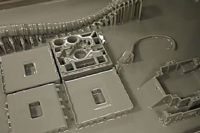To most people, cupcakes are a pleasant treat or a momentary diversion. But to Freed’s Bakery, one of the largest cupcake makers in the United States, cupcakes are big business. The company supplies in-store bakeries with iced and un-iced cupcakes in various sizes, flavors, colors and packaging.
Freed’s cupcakes often feature two-color icing, which is dispensed in the precise amount and pattern from a special machine located on the main automated production line. When Freed’s needed to replace this machine in 2012, the company learned it was no longer available or being serviced.
Looking to avoid a major production setback, Freed’s turned to 3-Dimensional Services Group for help. 3-Dimensional Services is a rapid prototyping firm that specializes in design, engineering and analysis, in-house tool construction, and complete build of first-off prototype parts and low- to medium-volume production runs.
Step one for 3-Dimensional was reverse engineering the run-down icing machine (disassembling it, dimensioning the components and drawing them) in order to create a CAD file. This file was imported into a stereolithography system to create a working 3D model of the machine. Reverse engineering and model creation took only one week.
Shortly thereafter, Freed’s approved the model, and 3-Dimensional Services built and delivered the replacement machine. However, Freed’s then wanted 3-Dimensional to build a redesigned machine. Specifically, the company sought a lighter machine that was easier to maintain and didn’t leak.
3-Dimensional focused first on the original machine’s hoses, which moved icing from mixing vats through heads to nozzle ports. Two hoses fed each port. Extended exposure to food-industry-strength cleaners made the hoses brittle and susceptible to breakage.
In addition, replacing them was difficult, time consuming and a major source of downtime. Each time a hose broke, Freed’s maintenance personnel had to remove all other hoses and clamps that stood in the way of the failed hose.
In the redesign, a runner system is cut into the aluminum plate of the machine’s interior to improve icing flow. This design also eliminates 24 of the original 48 hoses and allows a broken hose to be changed without removing good hoses.
With half as many hoses, the redesigned machine is much lighter. Two other design changes further help weight savings. The first is 3-Dimensional’s decision to replace conventional hose clamps with nickel-plated brass quick-connect fittings that quickly attach and reattach. The second is having two stainless steel rods, rather than four, serve as shut-off valves or petcocks.
Because it is lighter, the machine integrates easily with Freed’s lightweight equipment used for lower-volume production. It also draws less energy.
3-Dimensional’s final challenge was eliminating icing leakage. For the original machine to operate cleanly, each nozzle had to be screwed into place in perfect alignment with a port. This rarely happened, resulting in icing leakage within the machine and between both colors. Besides wasting product, the leakage caused downtime and quality concerns.
To solve this problem, 3-Dimensional tapered the tops of the plastic cylinders in the heads that channel the icing. It also placed a 0.01-inch gap between the cylinders and runner that forms a seal at the taper top during operation.
A spokesperson for Freed’s says the new icing machine has increased production by more than 50 percent. For more information on rapid prototyping, call 248-852-1333 or visit www.3dimensional.com.




